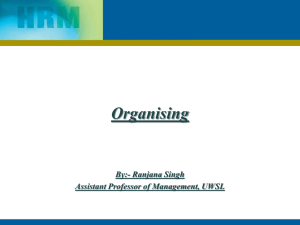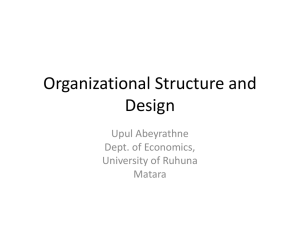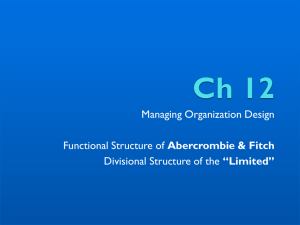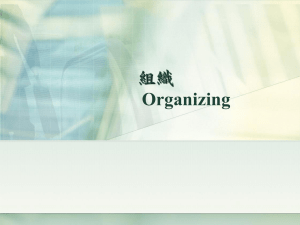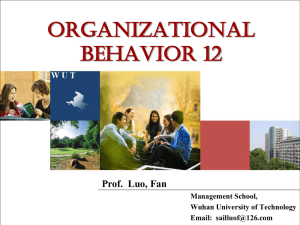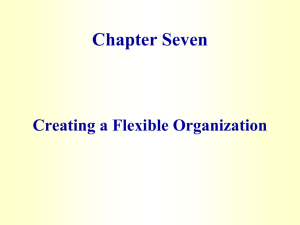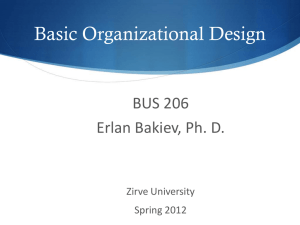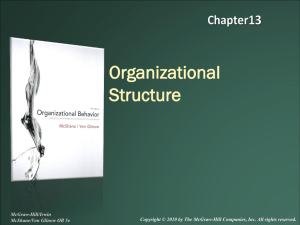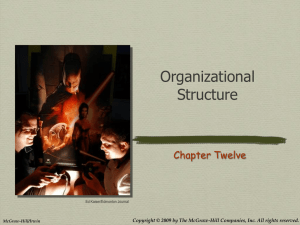Perilaku Organisasi dan Struktur Organisasi
advertisement
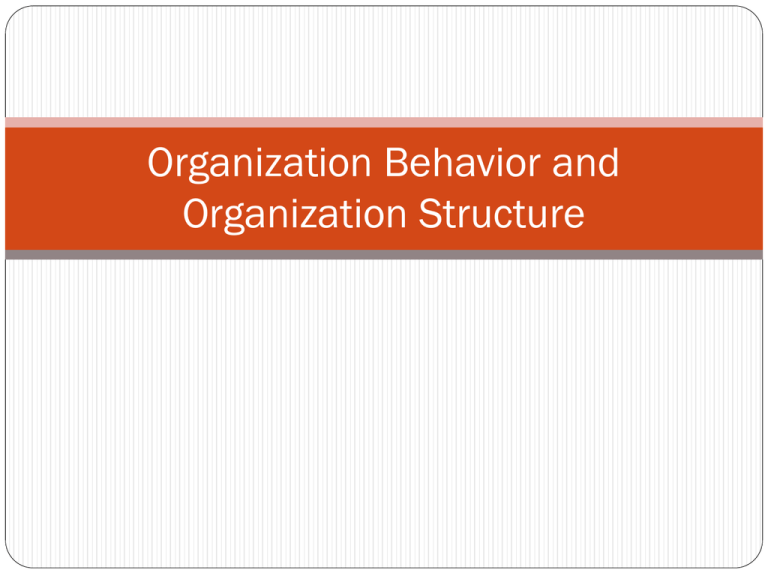
Organization Behavior and Organization Structure Organization Behavior A field of study that investigates the impact that individuals, groups, and structure have on behavior within organizations, for the purpose of applying such knowledge toward improving an organization effectiveness Stephen P. Robbins & Timothy A. Judge Organization Structure The way in which job tasks are formally divided, grouped, and coordinated Stephen P. Robbins & Timothy A. Judge 6 elements of Organization’s Structure Stephen P. Robbins & Timothy A. Judge 1. Work Specialization Describes the degree to which tasks in an organization are divided into separate jobs. The main idea of this organizational design is that an entire job is not done by one individual. It is broken down into steps, and a different person completes each step. Individual employees specialize in doing part of an activity rather than the entire activity. 2. Departmentalization The basis by which jobs in an organization are grouped together. For instance every organization has its own specific way of classifying and grouping work activities. 2. Departmentalization 5 common forms of departmentalization: 1. Functional departmentalization 2. Product departmentalization 3. Geographical departmentalization 4. Process departmentalization 5. Customer departmentalization Functional Departmentalization Plant Manager Manager engineering Manager Accounting Positive Manager manufacturing Manager HR Negative • Efficiencies from putting together similar specialties and people with common skills, knowledge and orientations • Poor communication across functional areas • coordination within functional area • Limited view of organizational goals • In- depth specialization Product Departmentalization Procter & Gamble Tide Pampers Positive Charmin Pringles Negative • Allows specialization in particular products • Duplication of function and services • Managers can become experts in their industry • Closer to customers • Limited view of organizational goals Geographical Departmentalization Vice President for Sales Sales Director Western Region Sales Director Southern Region Positive Sales Director Midwestern Region Sales Director Eastern Region Negative • More effective and efficient handling of specific regional issues that arise • Duplication of function • Serve needs of unique geographic markets better • Can feel isolated from other organizatonal areas Process Departmentalization State motor vehicle office Motor vehicles division Positive • More efficient flow of work activities Licensing department Treasury department Negative • can only be used with certain types of products Customer Departmentalization Director of sales Manager consumers account Manager large corporation account Positive • Customers need and problems can be met by specialists Manager software developers account Manager small business account Negative • Duplication of functions • Limited view of organizational goals 3. Chain of Command Unbroken line of authority that extends from the top of the organization to the lowest echelon and clarifies who reports to whom 2 important concept: 1. Authority: Refers to the rights inherent in a managerial position to tell people what to do and to expect them to do it 2. Unity of Command: The management principle that each person should report to only one manager 4. Span of Control The number of subordinates a manager can efficiently and effectively direct 5. Centralization and Decentralization Centralization: the degree to which decision making is concentrated at a single point in an organization Decentralization: decision making is pushed down to the managers closest to the action 6. Formalization The degree to which jobs within an organization are standardized Organizational Design Robbins Simple Structure Low degree of departmentalization, Wide span of control, High authority, and Low formalization. The company usually small and “young” Used by big company in crisis, for example IBM in 1993 Simple Structure Simple Structure Positive The structure is simple Flexible, fast and Low cost in implementation Negative Limitless decision making Insufficient if the company expands High risk in implementation Bureaucracy Structure Specialization on routine operational task Formalized regulation, centralized authority, narrow span of control and decision making follow the chain of command Applied on big and mature organization with active routine and high standarization, for example U.S Department of Education Bureaucracy Structure Bureaucracy Structure Positive Carry out standarized task efficiently Doesn’t require many employee training Negative Can create conflict between sub-unit Overly concern on rule, hence there is no initiative from the employees Increasse communication in Focus on sub-unit’s objective the organization Matrix Structure A combined structure of functional departmentalization and product departmentalization Two chain of command, so each employee has two superior Used by company that require fast response in changing environment, fast information processing, and dealing with financial and human resource constrain, for example : Bussiness Administration school Matrix Structure Matrix Structure Positive Negative Simplifying the activity Confusion in handing the coordination in the company report to either superior Easy to communicate between employees Employee with specific skill are spread in the organization Competition between managers Team Structure Using teams as main force in coordinating each job activities Desentralized decision making until team level Require the employee to work in specialization and generalization For Example; Food Market Inc. Virtual Organization Implenting Outsourcing for main functions and sentralization of the organization Focusing on organization specialization For Example: Apex Digital Virtual Organization Virtual Organization Positive Flexible in the implementation Negative Lack of control in the organization’s sub-units Boundaryless Organization Chain of command is erased, has unlimited span of control, and changing department with empowered team There are cross-hierarchy team, participative decision making, and 360 degree work valuation Employees are driven to generalisazing rather than specialisazing Organization remove the boundaries with external party For Example : Oticon A/S MCS & Organizational Structure An effective execution of MCS is possible only when there is an efficient HR management, excellent work culture as well as an efficient organization culture -Subhash Chandra Das Organization structure is a principal component in MCS’s structure. Organizational structure is a tool to distribute authority needed in using organization’s resource to achieve organization’s objective. –Mulyadi- Why do Structure Differ? Mechanistic Model : A structure characterized by extensive departmentalization, high formalization, a limited information network, and centralization Organic Model: A structure that is flat, uses cross- hierarchical and cross-functional teams, has low formalization, possesses a comprehensive information network, and relies on participate decision making Major causes or determinants of an organization’s structure: Strategy Innovation Cost Minimization Imitation Organization size Technology Environment

